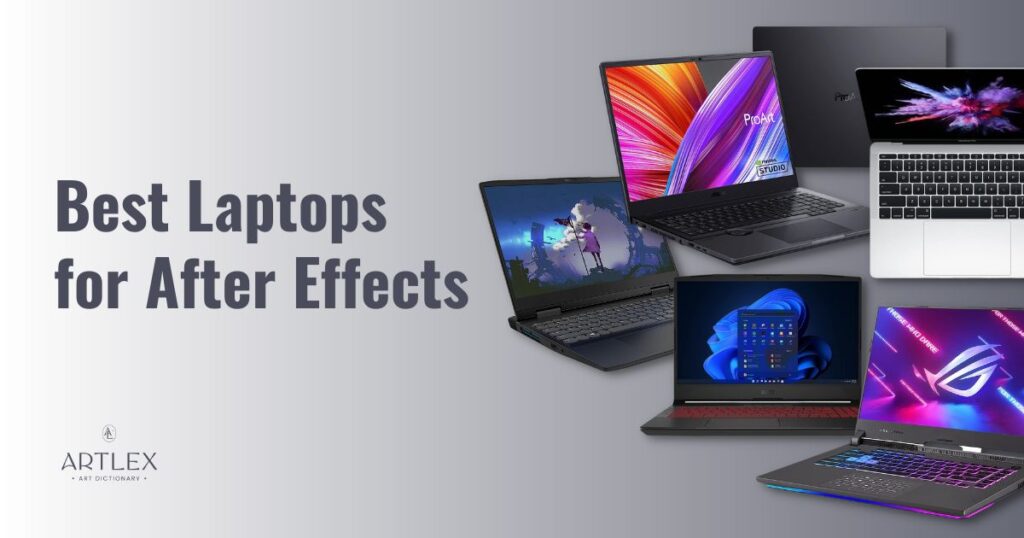
Are you ready to plunge into the mesmerizing world of video editing? Today, we are embarking on an exciting mission to find the ultimate laptop for running After Effects. Whether you’re creating jaw-dropping special effects, weaving together animations, or simply polishing up some footage for your YouTube channel, having the right laptop can make all the difference.
Finding the perfect laptop can feel a bit like looking for a needle in a haystack.
With so many options, technical specs, and brands, it’s easy to get lost. But fear not! This guide is to lend a hand, helping you navigate the sea of laptops to find your perfect match. We’ll break down all the tech stuff into easy-to-understand lingo, and walk through my hand-picked laptop suggestions to suit every budget and every level of experience.
So, sit back, grab a cup of tea, and let’s start this journey together! By the end of this post, I promise that you’ll feel more confident and prepared to find that dream laptop for your After Effects аdventures. Let’s get started!
Adobe After Effects: What is It, and Why It Craves Power
If you’re already familiar with this creative playground, feel free to skip ahead, but if you’re now or just a refresher, let me paint you a picture.
Adobe After Effects, or ‘AE’ is kind of like the Swiss army knife of video editing. It’s not just a software, it’s a canvas where dreams take shape – a magical world that lets you create and enhance animations, whip up splendid special effects, and even add a dash of color correction to your footage.
But all magic requires a touch of power. To make AE work its charm, you need the right laptop, you need something that can be the weight of your creations or else you’ll remain stuck and frustrated while your exports take forever and your edits choke your GPU.
Now we have a fair idea of AE’s potential and why a capable laptop is a must-have. Let’s continue our journey and uncover the secret recipe for a great AE-friendly laptop.
How to Find the Best Laptop for After Effects
CPU
Think of the CPU, or the Central Processing Unit, as the brain of your laptop. It’s responsible for making all the calculations and decisions. For After Effects, a strong CPU is essential becаuse AE loves doing “math homework” (calculating effects, rendering frames, etc.). Ideally, go for modern multi-core processors; they’re like having multiple brains working together!
The best CPUs for After Effects are the ones that have a high clock speed and a good number of cores. Some examples are the Intel Core i9 13900K and the i7 13700K, which have 16 and 12 cores respectively, and a maximum frequency of up to 5.3 GHz. Another option is the AMD Ryzen 9 7950X, which has 24 cores and a maximum frequency of 4.7 GHz
GPU
Next, let’s talk about the Graphics Processing Unit or GPU. Picture this as the “art team” of your laptop. It handles anything related to visuals. While After Effects primarily leans on the CPU, a capable GPU accelerates rendering and real-time previews. A dedicated GPU, especially the latest generations from NVIDIA or AMD, can give your AE performance a nice boost.
The best GPUs for After Effects are the ones that have a high amount of VRAM and support CUDA or OpenCL acceleration. Some examples are the NVIDIA GeForce RTX 3060 Ti, the RTX 3090, and the RTX 3080, which have 8 GB, 24 GB, and 10 GB of VRAM respectively, and support CUDA acceleration. Another option is the AMD Radeon RX 6800 XT, which has 16 GB of VRAM and supports OpenCL acceleration. These GPUs are very powerful for After Effects, especially for rendering 3D compositions, using ray-traced 3D renderer, and applying GPU-accelerated effects.
RAM
RAM, or Random Access Memory, is your laptop’s workspace. Think of it as a super-efficient office desk where all current tasks are laid out for quick access. More RAM means a bigger desk, allowing AE to work on more things simultaneously, especially important when working on complex projects. 16GB is a good starting point, but 32GB or more is the sweet spot for smooth sailing.
Storage
Storage is like your laptop’s warehouse. This is where all your files and software are stored when they’re not in use. SSDs (Solid State Drives) are faster, quieter, and more durable than their HDD (Hard Disk Drive) counterparts, meaning quicker boot times, faster file transfers, and less time waiting on your laptop to catch up. Aim for at least a 512GB SSD for a start.
Display
Last, but not least, the display. This is your window to everything you’re creating. Look for a high-resolution screen (Full HD at minimum), with a relatively high refresh rate, and if you’re serious about color grading, consider a laptop with an IPS panel for better color accuracy. Larger screens can give you more workspace, but remember, they also mаke the laptop bigger and heavier.
The brightness is also important, so try to get a laptop with at least 250 nits or more brightness, this will make the display easier to see in different lighting conditions and will allow you to work outside as well.
Battery Life
Though not a priority for many, the beauty of a laptop lies in its portability. From bustling cafes to client offices, a longer-lasting battery liberates you from the hunt for power outlets, letting your creativity flow wherever inspiration strikes.
However, portability is not the only perk of a long-lasting battery life, since a power outage can happen at any moment, a robust battery life can keep you going, ensuring you meet your deadlines no matter what. Lastly, a superior battery is not just about staying power; it also reflects the overall health of your laptop. It means fewer charging cycles, less battery wear, and a longer life span for your device.
Price
The price of your laptop, the literal cost of your digital dreams, is a vital factor in your buying decision. And trust me, there’s a wide spectrum of prices when it comes to laptops capable of running After Effects.
On one end, we’ve got budget-friendly models. They might not boast top-tier specs but can handle basic AE tasks admirably. If you’re a beginner or hobbyist, these could be your perfect match, offering the right balance between performance and affordability.
Sitting at the other end of the scale аre high-end powerhouses, boasting impressive processors, a surplus of RAM, high-resolution displays, etc If you’re a professional video editor dealing with complex projects, these machines, while pricier, will provide the smooth, efficient workflow you need.
Remember, though, the most expensive laptop isn’t necessarily the best one for you. It’s all about balancing your needs with your budget. Spend wisely, invest in the features you need most, and you’ll find a laptop that delivers great performance without breaking the bank. It’s all about making your money work for you!
Adobe’s Official Specifications
Every piece of software comes with a list of requirements, a set of standards to ensure it runs smoothly. For After Effects, Adobe sets the stage with two levels: ‘minimum’ and ‘recommended.’ The ‘minimum’ is like your entrance ticket to the show, while ‘recommended’ is your VIP pass to a stellar performance.
The ‘minimum’ might be enough if you’re just starting out or working on small projects. But trust me, as you start pushing the boundaries of your creativity, you’ll want to move towards the ‘recommended’ specs or even higher. Let’s take a look:
Minimum: Intel multi-core processor with 64-bit support, 16GB of RAM, 5GB of available hard-disk space, 2GB of GPU VRAM, and a 1280×1080 display.
Recommended: Fast modern multi-core processor (Intel i7 or higher), 32GB or more of RAM, a fast SSD with 10GB or more of available space, 4GB of GPU VRAM, and a high-resolution display (1920×1080 or greater).
Best Laptops for After Effects
- Best Laptop for After Effects Overall — Macbook Pro
- Best Laptop for After Effects for Beginners — Lenovo IdeaPad Gaming 3i
- Best Laptop for After Effects for Gaming — ASUS 2022 ROG Strix G15 Advantage
- Best Laptop for After Effects for Animators — ASUS ProArt StudioBook 16
- Best Laptop for After Effects on a Budget — MSI Pulse GL66 15″
1. Best Laptop for After Effects Overall — Macbook Pro
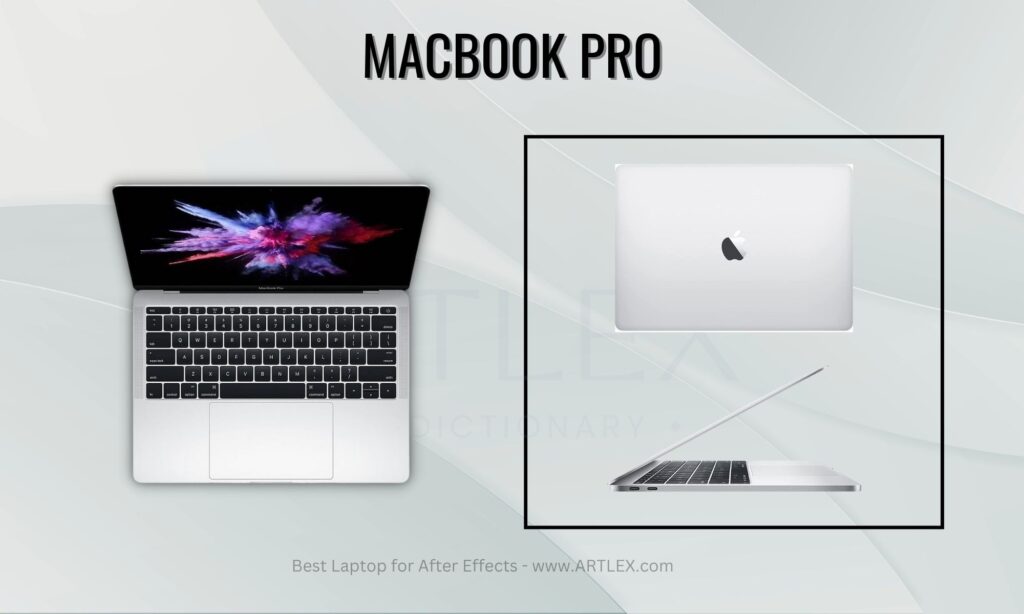
Selection Criteria:
- Display Resolution: 14.2-inch (diagonal) Liquid Retina XDR display, 3024×1964 native resolution at 254 pixels per inch
- Our Score: 9/10
- CPU and GPU: Apple M2 Pro chip10-core CPU with 6 performance cores and 4 efficiency cores, 16-core GPU, 16-core Neural Engine, 200GB/s memory bandwidth
- Our Score: 9/10
- RAM and Storage: 16GB, 512GB.
- Our Score: 8/10
- Battery Life: 21 Hours
- Our Score: 10/10
- Price: $1999
- Our Score: 8/10
About the Macbook Pro
The MacBook Pro, Apple’s flagship laptop, is a favorite among creative professionals, especially for demanding software like Adobe After Effects. The latest models with Apple’s own M2 Pro or M2 Max chips deliver impressive speed and efficiency, besides, with up to 64GB of unified memory, the MacBook Pro supports smooth multitasking and quick rendering, allowing you to manage multiple After Effects compositions effortlessly.
The fast SSD storage ensures rapid load times and file transfers, streamlining your workflow and its Retina Display, renowned for its color vibrancy and sharpness, will make your creations shine.
Even though it may be pricier, the MacBook Pro, with its powerful performance and high-quality features, is an investment worth considering for any serious Adobe After Effects user.
Pros
- Powerful Performance
- Superior Display
- Excellent Build Quality
- Long lasting battery
Cons:
- On the expensive side
- Non-upgradable
2. Best Laptop for After Effects for Beginners — Lenovo IdeaPad Gaming 3i
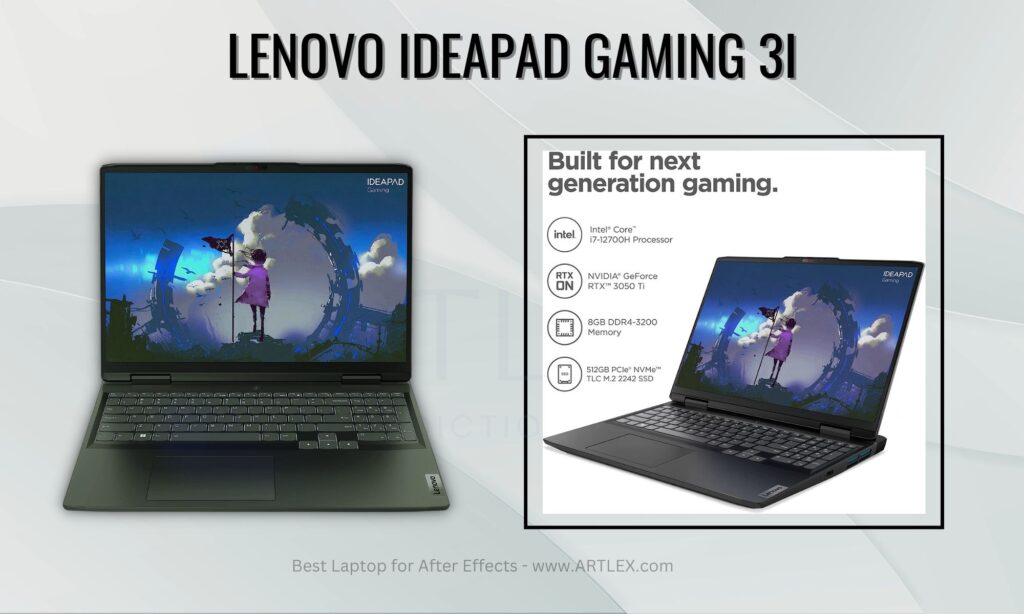
Selection Criteria:
- Display Resolution: 1920 x 1080 pixels, 15.6″ Full HD display.
- Our Score: 8/10
- CPU and GPU:Intel i7 12th Gen, NVIDIA GeForce GTX 3050 Ti.
- Our Score: 9/10
- RAM and Storage: 8GB RAM and 512GB SSD storage.
- Our Score: 8/10
- Battery Life: 8-9 Hours
- Our Score: 17/10
- Price: $759.99
- Our Score: 9/10
About the Lenovo IdeaPad Gaming 3i
Even though it has “gaming” on its name, the Lenovo IdeaPad 3i has everything you will need to start your video adventures and is the perfect starting laptop for After Effects. It goes beyond the recommended requirements of the software and also has a long lasting battery for those longer video editing sessions or long school days.
The laptop features a NVIDIA GeForce RTX 3050Ti graphics card, making it a solid pick for editing 1080p videos and whipping up stunning graphic designs. And with a 15.6-inch Full HD screen and 120Hz of refresh rate, you’ll enjoy sharp visuals whether you’re working or unwinding.
Now for the best part, this model comes with an affordable price tag, sitting around $900. That’s a steal for a machine that gets the job done without burning a hole in your pocket!
Pros
- Affordable Price
- Great CPU and GPU
- Upgradable RAM
Cons:
- Plastic Build
- Limited SSD Storage
- Below-average battery life
3. Best Laptop for After Effects for Gaming — ASUS 2022 ROG Strix G15 Advantage
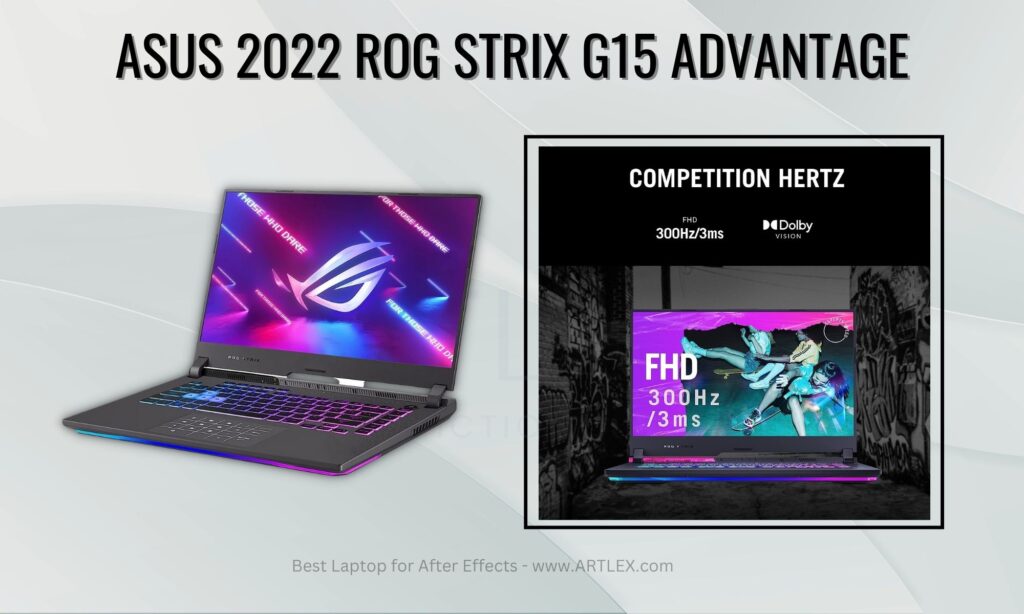
Selection Criteria:
- Display Resolution: 15.6” 300Hz FHD 1920×1080
- Our Score: 7/10
- CPU and GPU: AMD Ryzen 7 6800H, NVIDIA GTX 3060.
- Our Score: 9/10
- RAM and Storage: 16GB RAM and 512GB SSD.
- Our Score: 9/10
- Battery Life: 12 Hours
- Our Score: 8/10
- Price: $1,165.95
- Our Score: 8/10
About the ASUS 2022 ROG Strix G15 Advantage
This gaming powerhouse houses an AMD Ryzen 7 6800, one of the fastest around, coupled with a hefty (and expandable) 16GB of RAM, this dynamic duo is more than capable of handling complex After Effects projects, even when you’ve got multiple compositions open.
The laptop also brings an NVIDIA GeForce RTX 3060 to the table. This GPU not only offers top-notch gaming performance but also accelerates After Effects rendering, allowing for a smoother workflow and quicker turnaround times on your projects.
The laptop’s display is a dream for both gamers and video editors. With a 15. 6-inch Full HD screen and a whopping 300Hz refresh rate, you’re in for a treat with fluid motion and sharp visuals to fulfill all your gaming needs.
Pros
- Great refresh rate
- Newer model
- Upgradable RAM
Cons:
- Might need an external cooling solution
- It doesn’t include a webcam
4. Best Laptop for After Effects for Animators — ASUS ProArt StudioBook 16
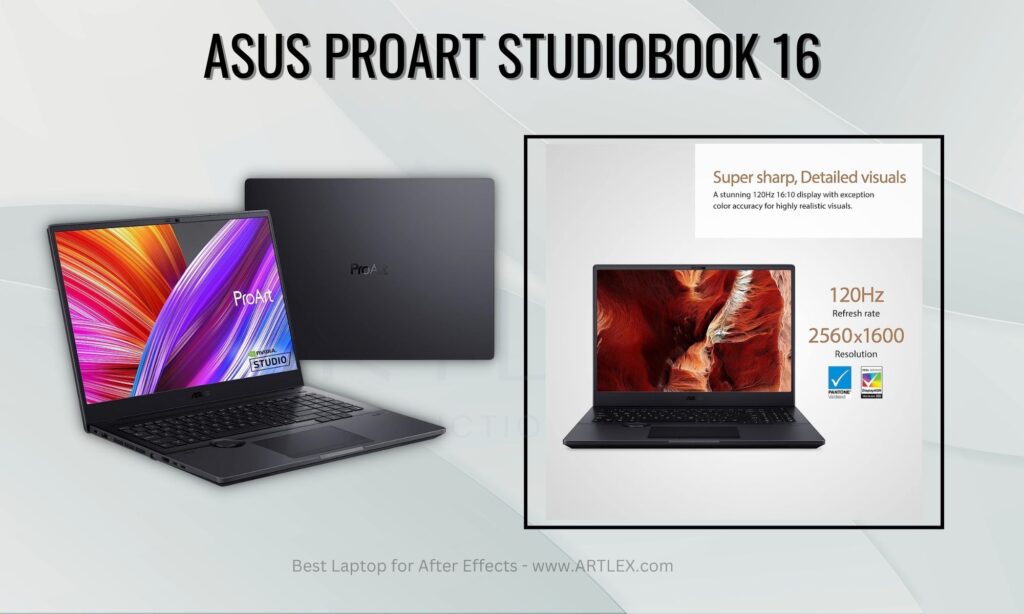
Selection Criteria:
- Display Resolution:16” (2560*1500) 16:10 120Hz display.
- Our Score: 7/10
- CPU and GPU: AMD Ryzen 7 5800H up to 4.4 GHz, NVIDIA GeForce GTX 3060.
- Our Score: 9/10
- RAM and Storage: 32GB RAM and 1 TB SSD.
- Our Score: 9/10
- Battery Life: 18-19 Hours
- Our Score: 10/10
- Price: $1,649.99
- Our Score: 8/10
About the ASUS ProArt StudioBook 16
The ASUS ProArt StudioBook 16 is the perfect option for all the artists and creatives out there, this laptop seamlessly blends power with creativity, promising a smooth and efficient After Effects experience.
Underneath its stylish exterior lies an AMD Ryzen 9 processor, backed by up to 64GB of RAM, ready to tackle the most complex After Effects compositions. What’s more, it comes with an NVIDIA RTX 3060 GPU, offering the power you need to handle GPU-accelerated effects without breaking a sweat. And let’s not forget the 16-inch display, a canvas for your creativity. With a 100% Adobe RGB and 100% DCI-P3 color coverage, you’ll get precise color representation, making it ideal for color grading and creating vivid animations.
Perhaps the crowning jewel of the StudioBook 16 is the ASUS Dial, a physical wheel interface that integrates with Adobe creative software, allowing you to adjust parameters in After Effects with a simple twist. While the ASUS ProArt StudioBook 16 might be a pricier option, it’s a dream come true for professional After Effects users.
Pros
- Integrated Dial
- Great CPU and GPU
- Full Adobe RGB Coverage
Cons:
- On the expensive side
- Might need an external cooling solution
5. Best Laptop for After Effects on a Budget — MSI Pulse GL66 15
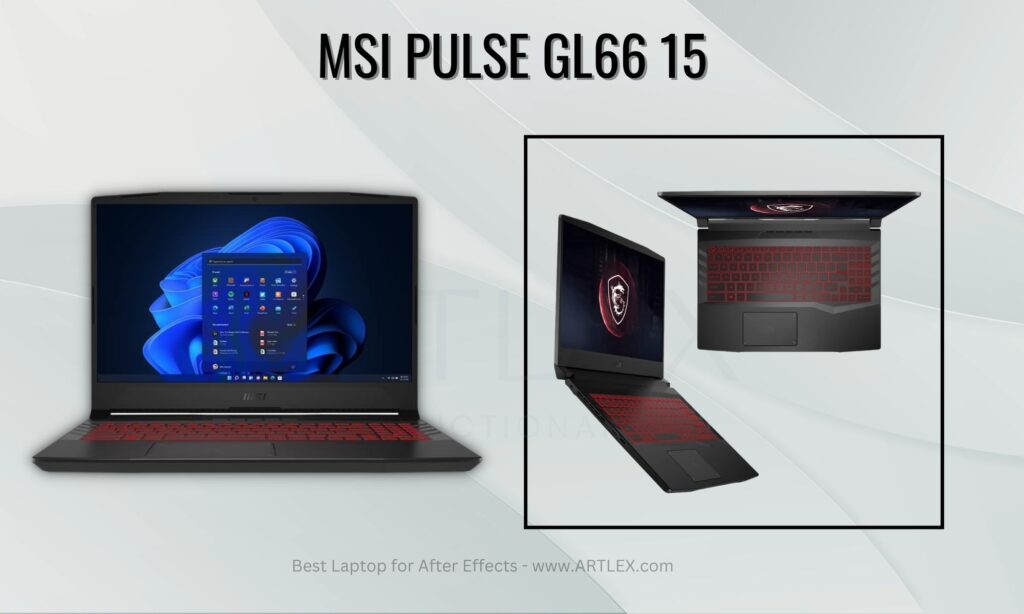
Selection Criteria:
- Display Resolution: 15.6″ FHD
- Our Score: 8/10
- CPU and GPU: Intel Core i5-11400H, NVIDIA GeForce GTX 3050
- Our Score: 9/10
- RAM and Storage: 16GB DDR4 512GB PCIe SSD.
- Our Score: 9/10
- Battery Life: 4-5 Hours
- Our Score: 6/10
- Price: $759.99
- Our Score: 9/10
About the MSI Pulse GL66 15
The MSI Pulse GL66 15 may not seem like your typical After Effects laptop, but trust me, it’s a hidden gem. It’s a prime example of how gaming laptops can cross over to the creative side and, with its combination of power and value, it deserves a spot on your shortlist.
At its heart lies an Intel Core i7 processor, coupled with a healthy 16GB of RAM. This pairing stands ready to tackle your After Effects tasks head-on, handling multiple compositions and effects with ease. The NVIDIA GeForce RTX 3060, while known for its gaming prowess, performs just as well in the realm of After Effects, accelerating rendering and contributing to a smoother and more efficient workflow.
Featuring a 15. 6-inch Full HD display with a fast 144Hz refresh rate, the MSI Pulse GL66 delivers crisp and smooth visuals, be it while crafting motion graphics or diving into an intense gaming session. Whether you’re a gamer who dabbles in After Effects or a creative looking for value, this laptop is well worth considering.
Pros
- High-Performance Specs
- Graphics Rendering Power
- Good Value for Money
Cons:
- Gaming aesthetics might not appeal to everyone
- Below average battery life



